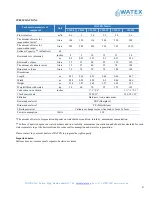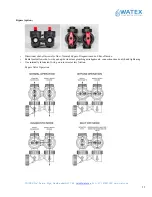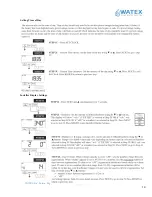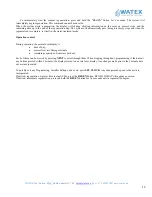
WATEX Ltd., Latvia, Riga, Ganibu dambis 27 k-5,
, Tel. +371 67381989, www.watex.eu
6
On the filtering tank of the filter is installed the CLACK WSCI control valve, which controls automatic regeneration of the
softener.
The control valve housing is made of plastic alloy. The control panel is located in front of the filter, and the water supply and
sewerage connections are in the rear.
The control valve is operated by voltage of 220 V. The control valve has the motherboard, which stores and regulates all the
rinse process parameters. To rinse the filter the voltage is fed from the motherboard to the built-in motor that moves a cylindrical
detail built-in the unit into a certain position.
On the left part of the control valve housing at the outlet manifold is a built-in meter that counts the quantity of water consumed.
The rinse algorithm is based on the volume of water consumed, which is counted by the built-in meter. Easy locking drain/ brine
clip for easy removal. Standard ¾” Male NPT 90° drain elbow that swivels 180° for easy orientation.
3/8” Parker Liquifit brine elbow that swivels 270° for easy orientation. Built in internal flow meter off the side of the outlet port
for easy maintenance.
2.1.2.
Brine tank
The brine tank is intended for storing Sodium Chloride NaCl (salt tablets). There are several components inside brine tank: a
safety float, brine well, grid plate. Normally the water level should be about 1/3 of the brine tank height. This is sufficient to
dissolve part of the NaCl regeneration cycle.
Brine well:
The brine well is a cylindrical barrier that keeps the salt or potassium chloride
away from the safety float and air check valve which allows them to operate without any
obstructions.
Brine Tank Safety Float:
A safety float is included inside the brine tank to ensure that salt
water does not overflow onto the floors if the injectors on the control valve get blocked up.
Float level can be adjusted, but in normal operation it is not necessary.
Grid plate (salt platform):
A grid plate is placed at the bottom of the brine tank. The grid
plate acts as a tool to displace the water. This allows more water to flow into the brine tank
to ensure that enough brine solution is available during the regeneration process.
Salt must be periodically added to the brine tank, it should be located where it is easily
accessible.
Fill salt cabinet when water level is above salt level. Do not mix different types of salt. If iron is present in your water, use a salt
with an iron-cleaning additive to help keep resin clean. You may also use a resin cleaner on a monthly basis in place of salt with
cleaning additives. If iron is not present in your water, a clean pellet, solar or cube type salt is recommended.
The use of rock salt is not recommended because it contains impurities that can plug up the injector assembly.
2.1.3.
Resin tank
The filter tank is filled with ion exchange resin (cationic), which reduces hardness and iron concentration in water. Capacity of
filter material is calculated according to amount of resins and raw water quality. When capacity is exhausted, regeneration by
salt is performed.




































